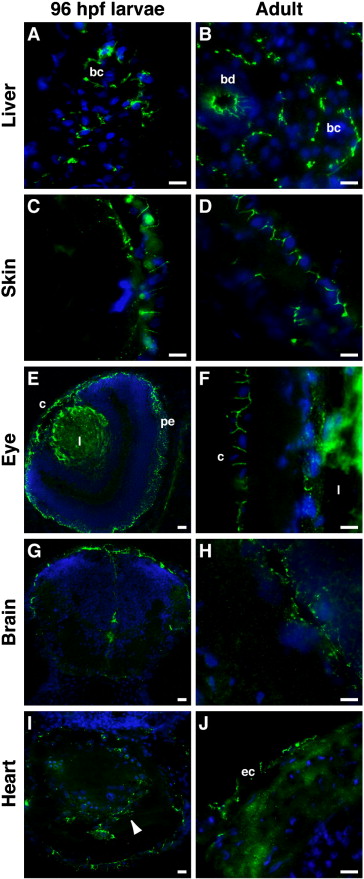Fig. S2 CAR is mainly found at epithelial cell?cell contacts in larvae and adult zebrafish. Immunohistochemical staining was performed, using the anti-CAR SIV antibodies, on cryo-sections from 96 hpf larvae and adult zebrafish. In the liver, CAR expression was found at cell?cell junctions between hepatocytes, forming the bile canaliculi (bc), in both larvae (A) and adult (B) zebrafish. CAR was also detected in adult bile ducts (bd; B). In the skin, CAR localized to epithelial cell?cell contacts (C and D). In the eye, CAR expression was found in the cornea (c) in both the larvae (E) and adult (F) zebrafish. CAR was also detected in the pigmented epithelium (pe) of the larvae (E). Immunoreactivity of the anti-CAR SIV antibody was observed in the lens (l; E and F). Both in the larvae (G) and adult (H) zebrafish brain, CAR expression was detected in cells lining the ventricles and the outer surface of the brain. In the larval heart (I, arrowhead), CAR expression was detected in the tissue, while the expression of CAR in the adult heart was found at cell?cell contacts in the epicardium (ec in J). DAPI was used to visualize the nuclei (blue). Scale bar, 50 μm.
Reprinted from Developmental Biology, 313(1), Raschperger, E., Neve, E.P., Wernerson, A., Hultenby, K., Pettersson, R.F., and Majumdar, A., The coxsackie and adenovirus receptor (CAR) is required for renal epithelial differentiation within the zebrafish pronephros, 455-464, Copyright (2008) with permission from Elsevier. Full text @ Dev. Biol.

